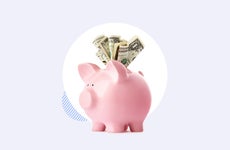How much money you could be missing out on with a low-APY savings account

The Bankrate promise
At Bankrate we strive to help you make smarter financial decisions. While we adhere to strict , this post may contain references to products from our partners. Here's an explanation for .
There’s some comfort in knowing that your money is in the bank down the street. But in the era of Federal Reserve rate increases and brick-and-mortar banks offering yields that are much lower than yields at many online banks, this comfort may be costing you money. Generally, Federal Deposit Insurance Corp. (FDIC) online banks offer savings accounts with much higher annual percentage yields (APYs) than brick-and-mortar banks.
What does APY mean?
APY stands for “annual percentage yield” and refers to the rate of return a bank of account earns in a year. APY includes the effects of compound interest, which means interest is earned on both your principal and the accumulated interest.
APYs on checking and savings accounts are variable, meaning the bank can raise or lower them, at will. Typically, banks with high-yielding accounts will increase APYs when the Federal Reserve raises rates, and lower APYs when the Fed decreases rates.
How a low APY can affect your savings
Let’s say you have saved $10,000. That’s a great accomplishment, but if it’s earning the national average of 0.58 percent APY, you’re not getting the best return on your savings. Some of the most popular big banks pay even less, at 0.01 percent.
There are many opportunities to earn a much better rate of around 5 percent APY or higher.
An account with $10,000 that pays 0.58 percent APY earns about $58 of interest in a year. In a high-yield savings account or money market account paying 5 percent APY, you’d earn around slightly more than $500in a year. And if you continue to add to your balance, you’ll earn more from compounding interest over time.
These calculations assume that the APY will stay the same for a year — which is unlikely to happen — and that you’re not withdrawing or adding any money.
Let’s say your balance isn’t quite as high as $10,000. These days, banks offer high-yield savings accounts paying up to around 5.25 percent APY with minimum balance requirements as low as $0. And while the earnings won’t differ as much on low balances, you can continue adding to your balance over time to maximize the higher yield.
With Bankrate’s compound interest calculator, you can see approximately how much interest you’re missing if you have a low-APY account.
Where is the best place to put your savings?
Your high-yield savings account is a great place for short-term savings goals and your emergency fund. Unlike most certificates of deposit (CDs), savings accounts allow easy access to your money, as needed, without charging a penalty. To find the best high-interest rate for you, browse Bankrate’s list of the best high-yield savings accounts.
You can have multiple savings accounts if you’d like to have separate places to store money for different goals. Or consider tools like Ally Bank’s buckets feature that lets you allocate money in your savings account to specific goals, such as a wedding fund and a home down payment fund.
Should you let your money sit in savings?
Experts recommend keeping your emergency fund in a high-yield savings account as well as money for short-term goals such as a home down payment or vacation. Short-term financial goals should be things you plan to accomplish within three years. Beyond that, the money may be better off in an account where it can have the chance to earn a higher return, such as a brokerage account.
High-yield savings accounts are great for emergency funds and short-term savings goals because the money is FDIC-insured — as long as you follow the FDIC’s rules and guidelines — and you can still earn a decent return on your money. Before you choose a savings account, confirm that it is FDIC-insured so you know your money is safe.
—Bankrate senior writer Karen Bennett contributed to an update of this story.
Related Articles



